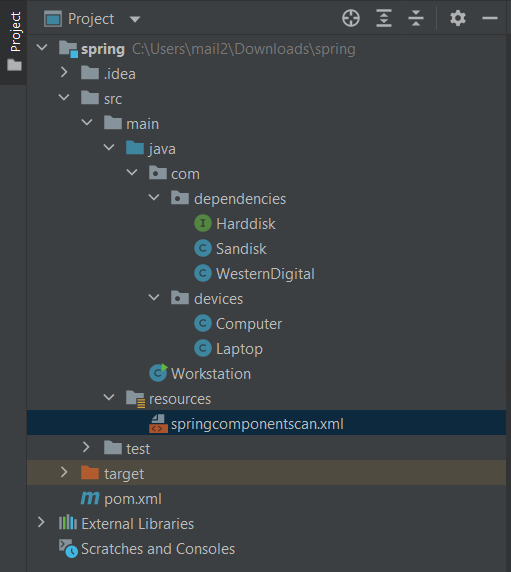Show List
Spring Dependency Injection using XML Configuration
This example shows different steps used for Spring dependency Injection using XML Configuration file. XML configuration file is used to create and wire beans. Below is the structure of the project we are going to create for this example


1. Create Maven project (From Java IDE go to File => New => Project => Maven Project) and add spring-context dependency. pom.xml:
<?xml version="1.0" encoding="UTF-8"?>
<project xmlns="http://maven.apache.org/POM/4.0.0"
xmlns:xsi="http://www.w3.org/2001/XMLSchema-instance"
xsi:schemaLocation="http://maven.apache.org/POM/4.0.0 http://maven.apache.org/xsd/maven-4.0.0.xsd">
<modelVersion>4.0.0</modelVersion>
<groupId>org.itcodescanner</groupId>
<artifactId>spring</artifactId>
<version>1.0-SNAPSHOT</version>
<properties>
<maven.compiler.source>11</maven.compiler.source>
<maven.compiler.target>11</maven.compiler.target>
</properties>
<dependencies>
<!-- https://mvnrepository.com/artifact/org.springframework/spring-context -->
<dependency>
<groupId>org.springframework</groupId>
<artifactId>spring-context</artifactId>
<version>5.3.22</version>
</dependency>
</dependencies>
</project>
2. Create Harddisk interface, Sanddisk and WesternDigital classes implementing Harddisk in com.dependencies package. Harddisk interface has signature for methods read and write. These methods will be overridden in Sandisk and WesternDigital classes.
package com.dependencies;
public interface Harddisk {
public void read();
public void write();
}
package com.dependencies;
public class Sandisk implements Harddisk{
@Override
public void read() {
System.out.println("Reading from Sandisk");
}
@Override
public void write() {
System.out.println("Writing from Sandisk");
}
}
package com.dependencies;
public class WesternDigital implements Harddisk{
@Override
public void read() {
System.out.println("Reading from WD");
}
@Override
public void write() {
System.out.println("Writing from WD");
}
}
3. Create consumer classes Computer and Laptop in the com.devices package. These classes have dependency on Harddisk but we are not specifying which Harddisk they are going to use inside the classes.
The Computer class has constructor with Harddisk argument which is passed to the class when object is created. Laptop has a setter for Harddisk property.
There is switchOn method which calls read and write methods of the harddisk.
package com.devices;
import com.dependencies.Harddisk;
public class Computer {
private Harddisk harddisk;
public Computer(Harddisk harddisk) {
this.harddisk = harddisk;
}
public void switchOn(){
System.out.println("Computer is switched on");
harddisk.read();
harddisk.write();
}
}
package com.devices;
import com.dependencies.Harddisk;
public class Laptop {
private Harddisk harddisk;
public void setHarddisk(Harddisk harddisk) {
this.harddisk = harddisk;
}
public void switchOn(){
System.out.println("Laptop is switched on");
harddisk.read();
harddisk.write();
}
}
4. Create xml file springwiring.xml in the resources folder. This file is going to create Harddisk beans and and pass them to objects (beans) of Computer and Laptop. Constructor injection is used while creating computer bean and setter injection is used while creating laptop bean.
In the constructor injection we pass the dependency through constructor argument. In the setter inject dependency is provided though property of the class.
<?xml version="1.0" encoding="UTF-8"?>
<beans xmlns="http://www.springframework.org/schema/beans"
xmlns:xsi="http://www.w3.org/2001/XMLSchema-instance"
xsi:schemaLocation="
http://www.springframework.org/schema/beans
http://www.springframework.org/schema/beans/spring-beans.xsd">
<bean id="harddiskA" class="com.dependencies.Sandisk" />
<bean id="harddiskB" class="com.dependencies.WesternDigital" />
<bean id="computer" class="com.devices.Computer">
<constructor-arg ref="harddiskA" />
</bean>
<bean id="laptop" class="com.devices.Laptop">
<property name="harddisk" ref="harddiskB" />
</bean>
</beans>
5. Create Workstation (main) class which will load the application context passing the xml to create and wire beans. Get the required bean from the application context and execute the method.
From the console output we can see that Sandisk was processed as dependency in the computer object and WD was processed as dependency in the laptop object.
import com.devices.Computer;
import com.devices.Laptop;
import org.springframework.context.ApplicationContext;
import org.springframework.context.support.ClassPathXmlApplicationContext;
public class Workstation {
public static void main(String[] args) {
ApplicationContext context
= new ClassPathXmlApplicationContext("springwiring.xml");
Computer computer = (Computer) context.getBean("computer");
computer.switchOn();
Laptop laptop = (Laptop) context.getBean("laptop");
laptop.switchOn();
}
}
Output:
Computer is switched on Reading from Sandisk Writing from Sandisk Laptop is switched on Reading from WD Writing from WD Process finished with exit code 0
Leave a Comment